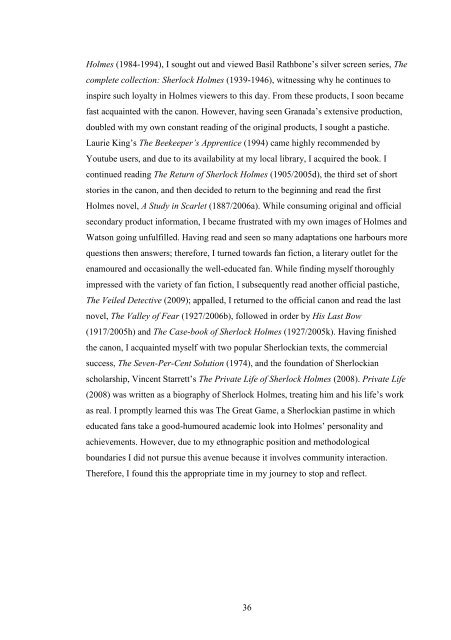The Case Study of Sherlock Holmes (2009) - Scholarly Commons ...
The Case Study of Sherlock Holmes (2009) - Scholarly Commons ...
The Case Study of Sherlock Holmes (2009) - Scholarly Commons ...
Create successful ePaper yourself
Turn your PDF publications into a flip-book with our unique Google optimized e-Paper software.
<strong>Holmes</strong> (1984-1994), I sought out and viewed Basil Rathbone‟s silver screen series, <strong>The</strong><br />
complete collection: <strong>Sherlock</strong> <strong>Holmes</strong> (1939-1946), witnessing why he continues to<br />
inspire such loyalty in <strong>Holmes</strong> viewers to this day. From these products, I soon became<br />
fast acquainted with the canon. However, having seen Granada‟s extensive production,<br />
doubled with my own constant reading <strong>of</strong> the original products, I sought a pastiche.<br />
Laurie King‟s <strong>The</strong> Beekeeper’s Apprentice (1994) came highly recommended by<br />
Youtube users, and due to its availability at my local library, I acquired the book. I<br />
continued reading <strong>The</strong> Return <strong>of</strong> <strong>Sherlock</strong> <strong>Holmes</strong> (1905/2005d), the third set <strong>of</strong> short<br />
stories in the canon, and then decided to return to the beginning and read the first<br />
<strong>Holmes</strong> novel, A <strong>Study</strong> in Scarlet (1887/2006a). While consuming original and <strong>of</strong>ficial<br />
secondary product information, I became frustrated with my own images <strong>of</strong> <strong>Holmes</strong> and<br />
Watson going unfulfilled. Having read and seen so many adaptations one harbours more<br />
questions then answers; therefore, I turned towards fan fiction, a literary outlet for the<br />
enamoured and occasionally the well-educated fan. While finding myself thoroughly<br />
impressed with the variety <strong>of</strong> fan fiction, I subsequently read another <strong>of</strong>ficial pastiche,<br />
<strong>The</strong> Veiled Detective (<strong>2009</strong>); appalled, I returned to the <strong>of</strong>ficial canon and read the last<br />
novel, <strong>The</strong> Valley <strong>of</strong> Fear (1927/2006b), followed in order by His Last Bow<br />
(1917/2005h) and <strong>The</strong> <strong>Case</strong>-book <strong>of</strong> <strong>Sherlock</strong> <strong>Holmes</strong> (1927/2005k). Having finished<br />
the canon, I acquainted myself with two popular <strong>Sherlock</strong>ian texts, the commercial<br />
success, <strong>The</strong> Seven-Per-Cent Solution (1974), and the foundation <strong>of</strong> <strong>Sherlock</strong>ian<br />
scholarship, Vincent Starrett‟s <strong>The</strong> Private Life <strong>of</strong> <strong>Sherlock</strong> <strong>Holmes</strong> (2008). Private Life<br />
(2008) was written as a biography <strong>of</strong> <strong>Sherlock</strong> <strong>Holmes</strong>, treating him and his life‟s work<br />
as real. I promptly learned this was <strong>The</strong> Great Game, a <strong>Sherlock</strong>ian pastime in which<br />
educated fans take a good-humoured academic look into <strong>Holmes</strong>‟ personality and<br />
achievements. However, due to my ethnographic position and methodological<br />
boundaries I did not pursue this avenue because it involves community interaction.<br />
<strong>The</strong>refore, I found this the appropriate time in my journey to stop and reflect.<br />
36

















